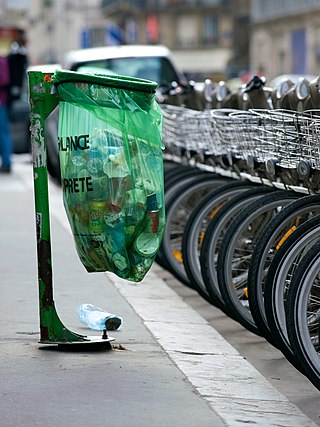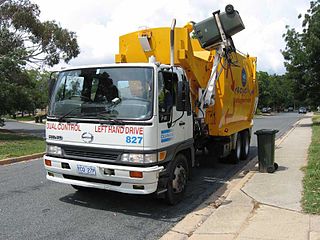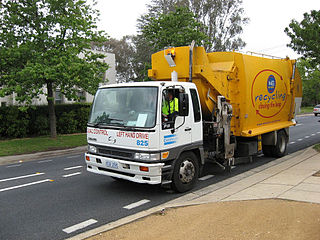History
Early work at University of Arizona
This section needs additional citations for verification .(April 2013) |
A. J. Weberman invented the word garbology in 1971 when he went through Bob Dylan's trash. [4] William Rathje's start of his ecologically oriented garbology excavations began in 1987. [5] Rathje was hoping to find more information regarding what the landfills contained as well as to examine how garbage reacts in its environment. During the time that Rathje was starting his projects many misconceptions began and the nation became more conscious of what they were throwing away. Many Americans started thinking the landfills were filled with their "most commonly used items"; fast food containers, disposable diapers, and Styrofoam. Rathje thinks this assumption derives from the fact that these items are often the most colorful and easy to spot. The industrial trash was not correctly accounted for before Rathje's project. According to charts before Rathje the amount of building material in the land fills was zero.
He started by surveying different areas of the country to better understand what types of garbage survives under different climates. He found there was little difference between the sites because the garbage is compacted. The California landfills did have less paper than those in Illinois. Recycling is thought to be the cause of the paper difference between states. Rathje's research uncovered some other misconceptions about landfills. In particular, it was revealed that the rate of natural biodegradation is far slower than had been assumed (e.g., in capacity planning). It was found that the plastic bottles that were crushed at the top were able to be re-inflated easier than those that were at the bottom because of a new system of bottle making called light-weighting. This is the process of using less plastic in bottles to conserve material and save money. Light-weighting is not limited to plastic alone; this process is used for aluminum and paper as well. Rathje also found that Americans were wrong about what they thought they threw away most. When combined, the three most infamous types of trash—diapers, fast food containers, and Styrofoam—amounted to less than three percent of the landfill's waste. Rathje found that plastic was 20-24% of waste and paper alone was 40 percent of the waste found in landfills. Thirteen percent of this paper waste was from newspapers. Rathje states the irony of this fact in his book. He talks about how newspapers are usually the ones that report things such as waste and pollution and it is these same newspapers clogging the landfills. Rathje discusses the rate of closing landfills and how for every six small landfills closed one large landfill opens. At the time he published his book he predicted that in the next five years 50 percent of the landfills open at the time would close. He determined this from his findings. In an effort for states to prevent their area becoming a large landfill often states ship their trash to other states. States such as Michigan are taking measures to prevent their state from being the landing spot for the nation's trash. [6] Michigan has found that in the past years most of their rise in trash rates are because of trash imports from Canada.
Present-day studies
Garbology today is used to assess waste and figure out new ideas for waste management. [7] Edward Humes estimated that the average US citizen produces 102 tons of refuse in their lifetime. [8]
Scientists are currently studying the floating mass of plastic trash in the Pacific Ocean. [9] The scientists study the effect of the trash on the marine life, and how to solve the rising problem. Another current study is the process of changing waste into energy. As both become a rising problem the methane in landfills has the potential to be used to generate small amounts of electricity. [10]
Garbology as an approach has been practiced by various fields like social sciences studies garbology how human have explored waste management and its various other uses while science uses waste management technologies. Different fields of study has explored the study of garbology and its uses. [11] Garbology as an anthropology study has been proved very helpful in exploring the past and discovering ancient sites using the 'litters', telltale domestic items, legible newspapers made their task easier. Household garbage proved to be more helpful and it required a lot of fieldwork and physical labour. Garbology is not mathematics, one needs to dig it, feel it, sort it. to smell it. [12]
Garbology has the potential to teach us more sustainable methods when it comes to managing our waste. Our lack of knowledge has resulted in many recyclable items being thrown out on a daily basis. [13] In response, many schools have incorporated garbology into the curriculum, with general focus on the three concepts of reduce, reuse, and recycle. [14] [15] Garbology Kids, a series of books written by Sabbithry Persad focuses primarily on teaching kids lessons about sustainable waste methods by offering useful sources and activities through various social media outlets. [16]
According to Environment America, as of 2021 the United States accounts for 12% of trash produced worldwide while only being made up of 4% of the total population. [17]
Green cities
Portland, Oregon consistently rates at the top of every list of sustainability, green buildings, recycling rates, clean transportation, energy efficiency, and eco businesses. Portland is considering implementing anaerobic digesters and plasma gasification that would efficiently decompose garbage. [8] : 250
Copenhagen, Denmark is the most efficient city in the world with garbage. 3 to 4 percent of the city's waste ends up in landfills. When compared to the 69 percent of the US's average, this is a very small percentage. Trash is largely incinerated and in the process used to generate electricity. Six out of ten Danish homes are heated this way. [8] : 255
Garbology is also what the community of Holden Village has called its communal sorting, separating, and disposal of landfill, recycling, and compostable items. Holden hires a full-time "Garbologist" who leads groups of community members in the sorting of the village waste.[ citation needed ]
Investigative uses
Another use of garbology is as an investigative tool of law enforcement, corporate espionage, or other types of investigations. This not only includes physical sorting of papers from a rubbish bin but also analysis of files found in a computer's recycle bin. The FBI ran "trash covers" against various organizations deemed subversive in the early 1950s. [18] The Trinity Foundation used such measures to demonstrate that the organization of the crooked televangelist Robert Tilton discarded prayer requests it received after removing the money inside. [19] In some countries garbology is illegal unless it is being used by the country's intelligence services. However journalists continue to use it to investigate the stories they produce.
Archaeologists have the availability to use old trash sites as a way to look into history and is helpful when referring to ancient civilizations. [20]












